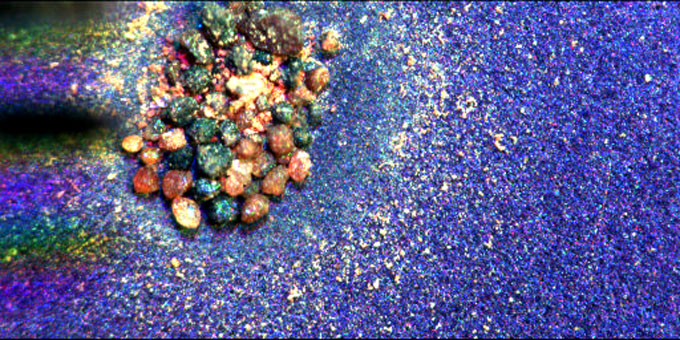Sand on Earth is continuously being created by the slow erosion of rocks. But on Mars, violent asteroid impacts may play an important role in making new sand.
As much as a quarter of Martian sand is composed of spherical bits of glass forged in the intense heat of impacts, a new study shows. Since windblown sand sculpts the Martian landscape, this discovery reveals how asteroid impacts contribute to shaping Mars, even long after the collisions occur, Purdue University planetary scientist Briony Horgan and colleagues suggest. The team will present their results August 18 at the 85th Annual Meeting of the Meteoritical Society in Glasgow, Scotland.
Using data collected by spacecraft orbiting Mars, Horgan and collaborators looked at different wavelengths of visible and infrared light reflected from the planet’s surface to determine the minerals present in Martian sand. The team found signatures of glass all over the planet, particularly at higher latitudes.
One explanation for all that glass is volcanic eruptions, which are known to produce glass when magma mixes with water. But the most glass-rich swath of Mars — the planet’s northern plains — is conspicuously bereft of volcanoes, the researchers note. That rules out volcanic eruptions as the culprit in that location and instead suggests that far more cataclysmic events — asteroid impacts — might be involved.
That’s a plausible argument, says Steven Goderis, a geochemist at the Vrije Universiteit Brussel in Belgium who was not involved in the research. “Often Mars is seen as a volcanic planet. But there’s also a very strong impact component, and this is often overlooked.”
When an asteroid moving at several kilometers per second slams into a rocky planet like Mars, the energy of the event melts nearby rocks and launches them skywards. That molten shrapnel fragments and produces sand grain–sized pieces that are roughly spherical. Those bits of glass — called impact spherules — eventually rain back onto the planet (SN: 3/31/21).

Over the last 3 billion years, asteroid impacts could have plausibly blanketed the surface of Mars in a layer of impact spherules roughly half a meter thick, Horgan and her colleagues calculate. All that material added to the sand on Mars that formed through normal erosion. “Impacts helped supply sand to the surface continuously over time,” Horgan says.
Scientists might have the opportunity to analyze Martian impact spherules in the future. NASA’s Perseverance rover is currently storing samples of Martian sand and rocks for eventual return to Earth (SN: 9/10/21). That’s exciting, Horgan says. “The record of all this is in the sand.”



